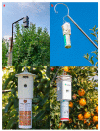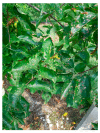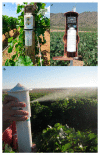Sex Pheromone Aerosol Devices for Mating Disruption: Challenges for a Brighter Future
- PMID: 31547095
- PMCID: PMC6835568
- DOI: 10.3390/insects10100308
Sex Pheromone Aerosol Devices for Mating Disruption: Challenges for a Brighter Future
Abstract
Pheromone-mediated mating disruption (MD) represents an important tool to manage insect pests in agriculture and forestry. MD relies on the release of synthetic sex pheromones from dispensers in crops, interfering with mate finding and reproduction of a pest through both competitive and non-competitive mechanisms. MD programs primarily rely upon "passive" dispensers, used at high densities per hectare (200-3000 units∙ha-1). In addition to the labor required for their application, another disadvantage of "passive" dispensers is the continuous release of pheromones, regardless of the time of day or the pest flight activity. Aerosol delivery systems can overcome the drawbacks of passive dispensers as they are applied at far lower density (2-5 units∙ha-1) and they can be programmed to release pheromones at selected time intervals when the target pest is active. However, the mode of action of aerosol dispensers is still not well understood and there are concerns of whether they are as effective as passive dispensers. This review focuses on the history of aerosol dispensers, mode of action, and effectiveness on various crops; deployment strategies; and the movement of pheromone once released. Limitations of aerosols and challenges for future research and commercial use are discussed.
Keywords: beetle pests; insect sex pheromones; integrated pest management; mealybugs; moth pests; precision agriculture.
Conflict of interest statement
The authors declare no conflict of interest. Mention of trade names or commercial products in this publication is solely for the purpose of providing specific information and does not imply recommendation or endorsement by the University of Pisa (Pisa, Italy), E. Mach Foundation (San Michele all’Adige, Italy) and the Pacific Biocontrol Corporation (Vancouver, Canada).
Figures



References
-
- Hillocks R.J. Farming with fewer pesticides: EU pesticide review and resulting challenges for UK agriculture. Crop Prot. 2012;31:85–93. doi: 10.1016/j.cropro.2011.08.008. - DOI
-
- Welter S., Pickel C., Millar J., Cave F., Van Steenwyk R., Dunley J. Pheromone mating disruption offers selective management options for key pests. Calif. Agric. 2005;59:16–22. doi: 10.3733/ca.v059n01p16. - DOI
Publication types
LinkOut - more resources
Full Text Sources
Other Literature Sources

